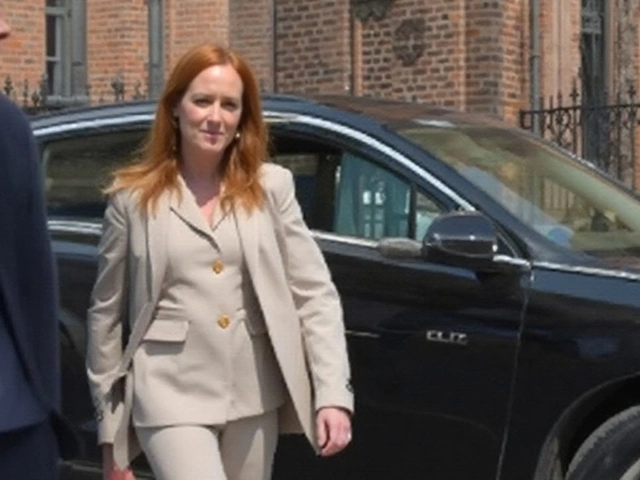The FTSE 100 plunged to its lowest level in a month on Friday, November 14, 2025, sinking to 9,422.85 before settling at 9,486.54 — a 0.44% drop that sent ripples through London’s financial corridors. The slide wasn’t driven by a single shock, but by a cascade of grim signals: retail sales fell 1.1% in October, consumer confidence hit a two-year low, and services activity barely scraped by in expansion territory. For ordinary Britons, this isn’t just market noise — it’s the sound of household budgets tightening before the autumn budget next week.
What’s Really Going On With UK Spending?
Data from the Office for National Statistics revealed a startling reversal: UK retail sales dropped 1.1% month-on-month in October 2025, the first decline in five months. Economists had expected a modest 0.1% rise. That’s not a blip — it’s a trend. The previous month, sales had surged 0.7%. Now, shoppers are pulling back. Supermarkets, fuel stations, and high-street retailers are feeling it. Why? Inflation’s ghost still haunts wallets. And with wages barely keeping pace, people are trading down, delaying big purchases, or just saying no.Consumer Confidence: The Quiet Crisis
Meanwhile, the GfK consumer sentiment index tumbled to -19 in November, down two points from October. That’s the lowest since early 2023. Neil Bellamy, Neil Bellamy, Consumer Insights Director at GfK, didn’t mince words: "This is a bleak set of results as we head towards next week’s Budget. A fall across all five measures suggests the public is bracing for difficult news, with little in the current climate to lift expectations." The five measures? Expectations for personal finances, general economic conditions, unemployment, saving, and spending. All sinking. That’s not pessimism — it’s preparation for pain.Services Sector: The Engine That’s Sputtering
The S&P Global UK Composite PMI dropped to 50.5 in November from 52.2 the month before. Anything above 50 means growth — but barely. The services sector, which makes up 80% of the UK economy, fell to 50.5 from 52.3. That’s the weakest reading since January. Meanwhile, manufacturing edged up to 50.2 — a rare bright spot, but too small to offset the broader slump. What’s happening? Businesses are scaling back hiring. Orders are drying up. And confidence among service providers — from hairdressers to accountants — is evaporating.Market Reaction: A Fleeting Recovery
The next day, the FTSE 100 clawed back some ground, closing up 0.2% at 9,527.65. It ended a five-day losing streak. Intraday, it even hit 9,593.83. But don’t mistake this for a rebound. The rally was fueled by mixed US jobs data — not UK strength. ING analysts noted it would likely "keep the Fed hawkish," meaning higher US interest rates could keep the pound weak and British exports less competitive. With no major UK data due before the December 10 Federal Reserve meeting, traders were just playing the waiting game.Historical Context: A Pattern of Volatility
The FTSE 100 has been on a rollercoaster since early November. On November 11, it hit 9,899.60 — a high not seen since May. By November 20, it was down nearly 5%. That kind of whiplash is normal in uncertain times. Historically, the index has posted positive returns in 58% of months since 2000, according to Curvo.eu. Its best months? November 2020 (+13.1%) and April 2009 (+13.0%) — both post-crisis rebounds. This time? No such relief in sight.What’s Next? The Budget and the Bank
All eyes are now on Chancellor Rachel Reeves’ autumn budget, due next week. Will she announce tax hikes? Spending cuts? Or a surprise stimulus? The Bank of England is watching too. Inflation is cooling, but core prices remain stubborn. If consumer demand keeps fading, the BoE might delay rate cuts — even as households struggle. Meanwhile, the London Stock Exchange Group reported "Transaction in Own Shares" filings on November 20 — a routine corporate activity, but one that sometimes signals insider confidence (or lack thereof). No details were released.Why This Matters Beyond the Numbers
This isn’t just about stock charts. When retail sales fall and confidence drops, it means families are cutting back on groceries, skipping repairs, delaying holidays. Small businesses — the backbone of local economies — are the first to feel it. And when the services sector slows, so do jobs. The UK’s recovery from pandemic-era debt and inflation has always been fragile. Now, it’s showing its cracks. The FTSE 100 may bounce again. But without real income growth and renewed consumer trust, any rally will be paper-thin.Frequently Asked Questions
Why did retail sales drop so sharply in October 2025?
Retail sales fell 1.1% month-on-month — the first decline in five months — as households faced persistent inflation and stagnant wage growth. Many consumers shifted to discount retailers, delayed non-essential purchases, and reduced spending on dining and entertainment. The previous month’s 0.7% surge had been fueled by a temporary boost from back-to-school spending and seasonal promotions, which didn’t repeat.
How does the GfK consumer confidence index of -19 compare historically?
A reading of -19 is the lowest since February 2023 and places UK consumer sentiment in the bottom 10% of readings since GfK began tracking in 2004. For context, the long-term average is around -12. Readings below -20 typically precede recessions. The fact that all five components — personal finances, economy, unemployment, saving, and spending — declined together signals broad-based pessimism, not just isolated concerns.
What does the S&P Global UK Composite PMI at 50.5 tell us about the economy?
A PMI of 50.5 means the private sector is barely growing — the weakest pace since January 2025. The services sector, which dominates the economy, is at a 10-month low. Businesses reported lower new orders, reduced hiring, and cautious inventory management. While manufacturing improved slightly, it’s too small to offset the service sector’s drag. This suggests the UK is flirting with stagnation, not growth.
Could the autumn budget trigger a market rally or further decline?
If the budget includes tax cuts for low- and middle-income households or targeted support for small businesses, markets could rally on renewed hope for demand. But if it brings VAT hikes, public sector pay freezes, or benefit cuts — as many analysts fear — the FTSE 100 could drop below 9,400 again. The market is pricing in austerity. A surprise stimulus might be the only thing that breaks the negative cycle.
How are global factors like the US dollar and Fed policy affecting the FTSE 100?
The US dollar’s strength in October 2025, driven by expectations of prolonged Fed rate hikes, made the pound weaker — hurting UK exporters and inflating import costs. While the FTSE 100 includes many multinational firms that benefit from a weak pound, domestic-focused companies — like retailers and service providers — suffer. Mixed US jobs data in mid-November briefly lifted the index, but only because traders hoped the Fed wouldn’t cut rates too soon, preserving the dollar’s strength.
Is this downturn similar to past UK economic slumps?
It’s reminiscent of late 2022, when inflation peaked and real incomes collapsed. But this time, there’s no energy price shock driving it. Instead, it’s a slow burn: wage stagnation, high interest rates, and eroded confidence. Unlike the 2008 crisis or 2020 pandemic, there’s no clear external trigger. That makes it harder to fix — and more dangerous, because it’s rooted in everyday financial stress, not systemic collapse.




